Evidence-Based Practice Research: Managing High Blood Pressure
VerifiedAdded on 2022/10/16
|10
|2336
|162
Report
AI Summary
This report examines evidence-based practice research on high blood pressure, focusing on its impact on adults and effective management strategies. The introduction highlights the significance of evidence-based nursing in transforming healthcare through safe and efficient services, emphasizing the use of research to improve patient outcomes. The body of the report identifies high blood pressure as a prevalent clinical problem, detailing its risks and symptoms, as well as a clinical case study. It incorporates a clinical question about the effects of high blood pressure and reviews the evidence-based search strategy, including qualitative research and literature synthesis. The report synthesizes findings from multiple sources, including study details, outcomes, and limitations. It provides recommendations for practice change and further research, focusing on the need for increased education, improved implementation of research findings, and lifestyle modifications to reduce the impact of hypertension. The report emphasizes the importance of evidence-based practice in improving patient care and reducing healthcare costs associated with high blood pressure.

RUNNING HEADER: EVIDENCE-BASED PRACTICE RESEARCH 1
Evidence-Based Practice Research
Students Name
Institutional Affiliation
Evidence-Based Practice Research
Students Name
Institutional Affiliation
Paraphrase This Document
Need a fresh take? Get an instant paraphrase of this document with our AI Paraphraser
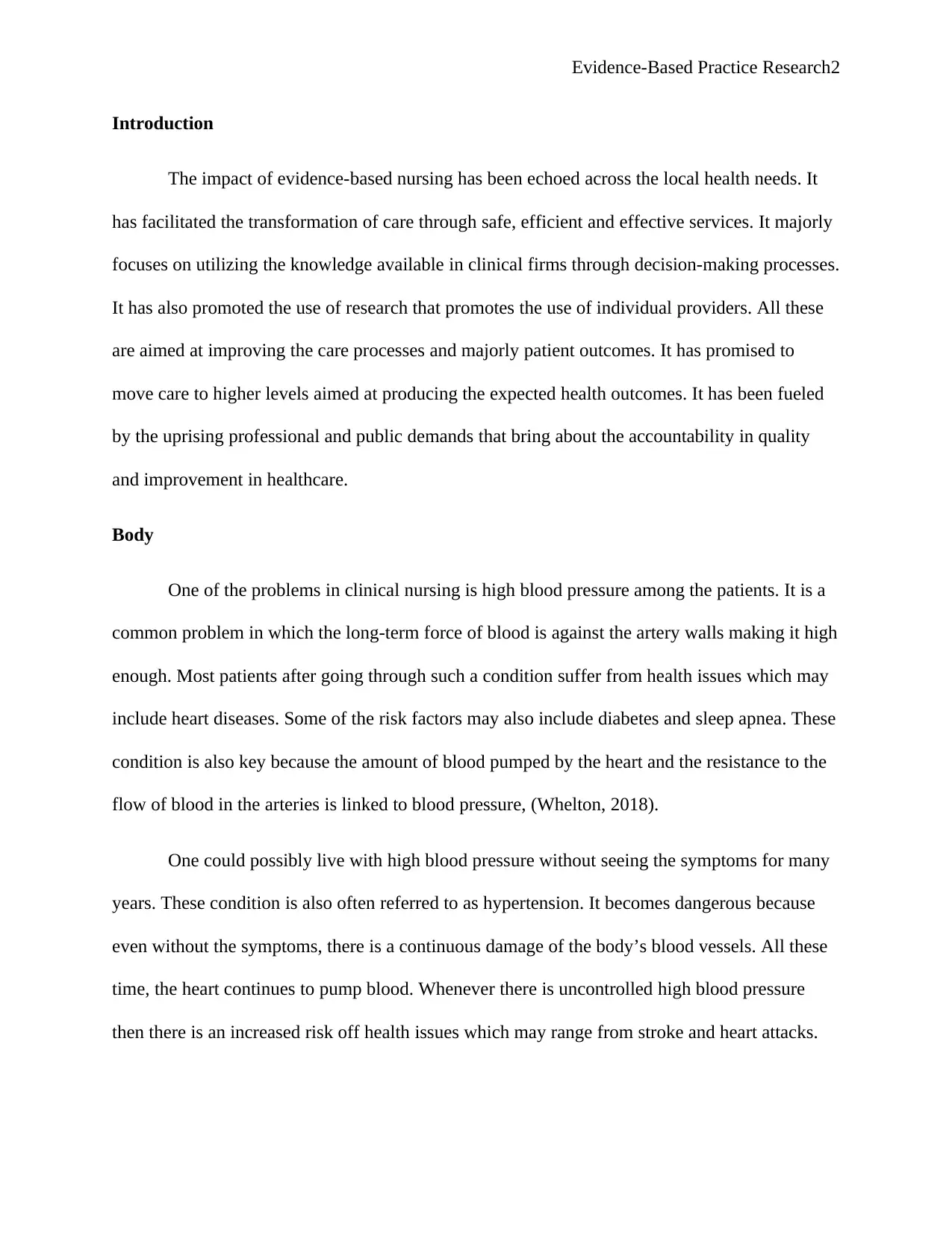
Evidence-Based Practice Research2
Introduction
The impact of evidence-based nursing has been echoed across the local health needs. It
has facilitated the transformation of care through safe, efficient and effective services. It majorly
focuses on utilizing the knowledge available in clinical firms through decision-making processes.
It has also promoted the use of research that promotes the use of individual providers. All these
are aimed at improving the care processes and majorly patient outcomes. It has promised to
move care to higher levels aimed at producing the expected health outcomes. It has been fueled
by the uprising professional and public demands that bring about the accountability in quality
and improvement in healthcare.
Body
One of the problems in clinical nursing is high blood pressure among the patients. It is a
common problem in which the long-term force of blood is against the artery walls making it high
enough. Most patients after going through such a condition suffer from health issues which may
include heart diseases. Some of the risk factors may also include diabetes and sleep apnea. These
condition is also key because the amount of blood pumped by the heart and the resistance to the
flow of blood in the arteries is linked to blood pressure, (Whelton, 2018).
One could possibly live with high blood pressure without seeing the symptoms for many
years. These condition is also often referred to as hypertension. It becomes dangerous because
even without the symptoms, there is a continuous damage of the body’s blood vessels. All these
time, the heart continues to pump blood. Whenever there is uncontrolled high blood pressure
then there is an increased risk off health issues which may range from stroke and heart attacks.
Introduction
The impact of evidence-based nursing has been echoed across the local health needs. It
has facilitated the transformation of care through safe, efficient and effective services. It majorly
focuses on utilizing the knowledge available in clinical firms through decision-making processes.
It has also promoted the use of research that promotes the use of individual providers. All these
are aimed at improving the care processes and majorly patient outcomes. It has promised to
move care to higher levels aimed at producing the expected health outcomes. It has been fueled
by the uprising professional and public demands that bring about the accountability in quality
and improvement in healthcare.
Body
One of the problems in clinical nursing is high blood pressure among the patients. It is a
common problem in which the long-term force of blood is against the artery walls making it high
enough. Most patients after going through such a condition suffer from health issues which may
include heart diseases. Some of the risk factors may also include diabetes and sleep apnea. These
condition is also key because the amount of blood pumped by the heart and the resistance to the
flow of blood in the arteries is linked to blood pressure, (Whelton, 2018).
One could possibly live with high blood pressure without seeing the symptoms for many
years. These condition is also often referred to as hypertension. It becomes dangerous because
even without the symptoms, there is a continuous damage of the body’s blood vessels. All these
time, the heart continues to pump blood. Whenever there is uncontrolled high blood pressure
then there is an increased risk off health issues which may range from stroke and heart attacks.
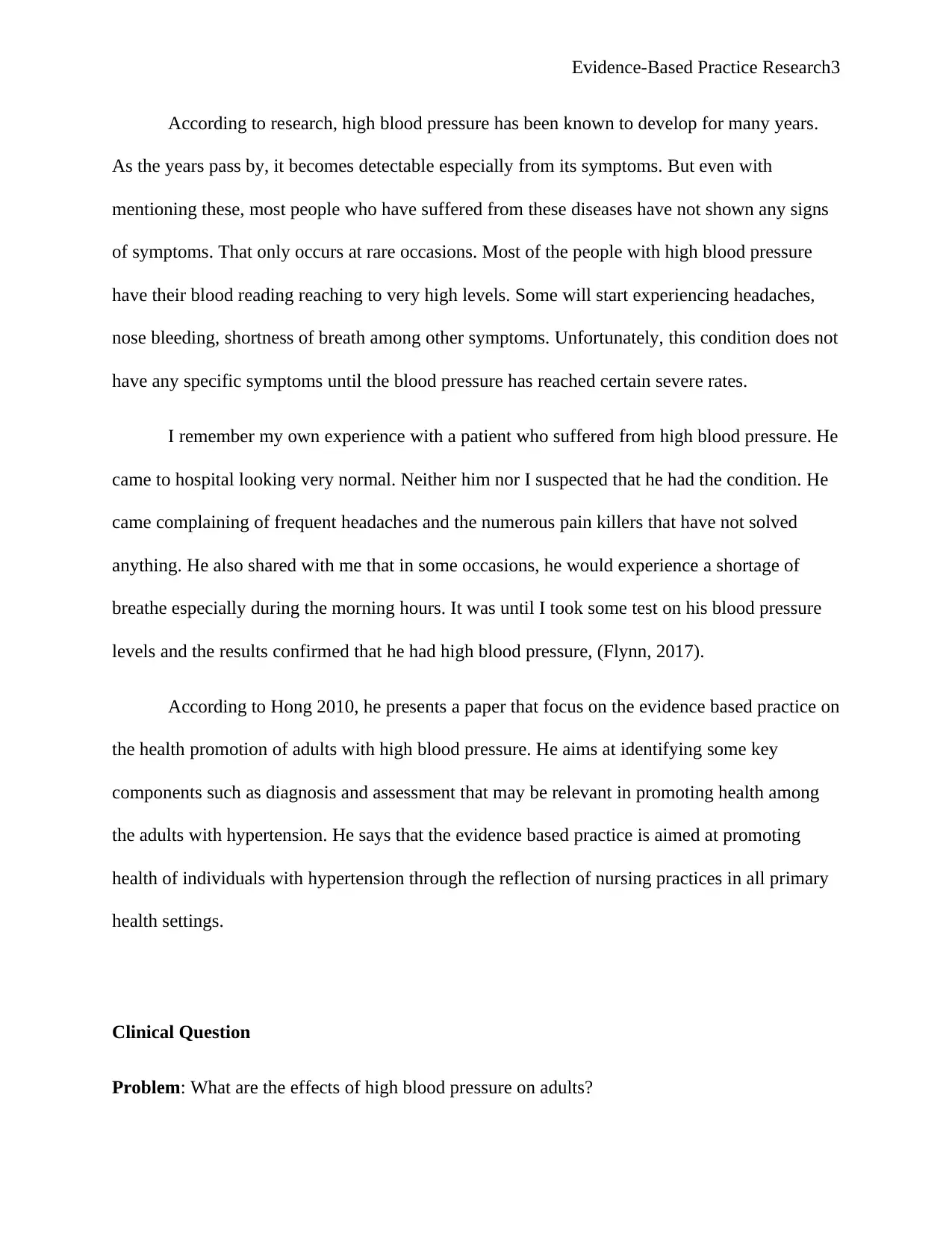
Evidence-Based Practice Research3
According to research, high blood pressure has been known to develop for many years.
As the years pass by, it becomes detectable especially from its symptoms. But even with
mentioning these, most people who have suffered from these diseases have not shown any signs
of symptoms. That only occurs at rare occasions. Most of the people with high blood pressure
have their blood reading reaching to very high levels. Some will start experiencing headaches,
nose bleeding, shortness of breath among other symptoms. Unfortunately, this condition does not
have any specific symptoms until the blood pressure has reached certain severe rates.
I remember my own experience with a patient who suffered from high blood pressure. He
came to hospital looking very normal. Neither him nor I suspected that he had the condition. He
came complaining of frequent headaches and the numerous pain killers that have not solved
anything. He also shared with me that in some occasions, he would experience a shortage of
breathe especially during the morning hours. It was until I took some test on his blood pressure
levels and the results confirmed that he had high blood pressure, (Flynn, 2017).
According to Hong 2010, he presents a paper that focus on the evidence based practice on
the health promotion of adults with high blood pressure. He aims at identifying some key
components such as diagnosis and assessment that may be relevant in promoting health among
the adults with hypertension. He says that the evidence based practice is aimed at promoting
health of individuals with hypertension through the reflection of nursing practices in all primary
health settings.
Clinical Question
Problem: What are the effects of high blood pressure on adults?
According to research, high blood pressure has been known to develop for many years.
As the years pass by, it becomes detectable especially from its symptoms. But even with
mentioning these, most people who have suffered from these diseases have not shown any signs
of symptoms. That only occurs at rare occasions. Most of the people with high blood pressure
have their blood reading reaching to very high levels. Some will start experiencing headaches,
nose bleeding, shortness of breath among other symptoms. Unfortunately, this condition does not
have any specific symptoms until the blood pressure has reached certain severe rates.
I remember my own experience with a patient who suffered from high blood pressure. He
came to hospital looking very normal. Neither him nor I suspected that he had the condition. He
came complaining of frequent headaches and the numerous pain killers that have not solved
anything. He also shared with me that in some occasions, he would experience a shortage of
breathe especially during the morning hours. It was until I took some test on his blood pressure
levels and the results confirmed that he had high blood pressure, (Flynn, 2017).
According to Hong 2010, he presents a paper that focus on the evidence based practice on
the health promotion of adults with high blood pressure. He aims at identifying some key
components such as diagnosis and assessment that may be relevant in promoting health among
the adults with hypertension. He says that the evidence based practice is aimed at promoting
health of individuals with hypertension through the reflection of nursing practices in all primary
health settings.
Clinical Question
Problem: What are the effects of high blood pressure on adults?
⊘ This is a preview!⊘
Do you want full access?
Subscribe today to unlock all pages.

Trusted by 1+ million students worldwide

Evidence-Based Practice Research4
Intervention: Evidence-based practice has provided scientific proof that reveals that high blood
pressure has diastatic effects. It seeks to bring out the implications of high blood pressure. They
recommend that people with high blood pressure should walk and exercise more frequently. The
impairment caused by high blood pressure can be controlled even without medication.
Control: High blood pressure can be controlled without medication.
Outcomes: leads to stroke, weakening of brain blood vessels, blood clots, dementia among
others.
Evidence Search
The evidence-based search strategy is majorly preoccupied with education as its major
means of approach. These would include the discussions and lectures that are often meant to
explore the possible solutions for the effects of high blood pressure. The evidence-based practice
can only be successful if and only if the patients agree to its usefulness and adopt the positive
impact that it has on them. It also aims at creating a problem-solving approach to the prevalent
clinical practices that incorporate evidence from well-researched studies.
In this case, the Boolean operators were used as the key search strategies allowing the
researches to use keywords linked to operators which include NOT, OR and AND to help
produce relevant results.
My qualitative search focuses on the work of Afzal 2017. The qualitative design involved
an analysis approach. Twenty-seven patients with high blood pressure were referred to a hospital
that is affiliated to Tehran University of Medical Sciences. They took part in the study and some
semi-structured interviews were incorporated to help in the collection of data. There was also an
analysis of interviews analyzed using some interpretative phenomenological analysis. The
Intervention: Evidence-based practice has provided scientific proof that reveals that high blood
pressure has diastatic effects. It seeks to bring out the implications of high blood pressure. They
recommend that people with high blood pressure should walk and exercise more frequently. The
impairment caused by high blood pressure can be controlled even without medication.
Control: High blood pressure can be controlled without medication.
Outcomes: leads to stroke, weakening of brain blood vessels, blood clots, dementia among
others.
Evidence Search
The evidence-based search strategy is majorly preoccupied with education as its major
means of approach. These would include the discussions and lectures that are often meant to
explore the possible solutions for the effects of high blood pressure. The evidence-based practice
can only be successful if and only if the patients agree to its usefulness and adopt the positive
impact that it has on them. It also aims at creating a problem-solving approach to the prevalent
clinical practices that incorporate evidence from well-researched studies.
In this case, the Boolean operators were used as the key search strategies allowing the
researches to use keywords linked to operators which include NOT, OR and AND to help
produce relevant results.
My qualitative search focuses on the work of Afzal 2017. The qualitative design involved
an analysis approach. Twenty-seven patients with high blood pressure were referred to a hospital
that is affiliated to Tehran University of Medical Sciences. They took part in the study and some
semi-structured interviews were incorporated to help in the collection of data. There was also an
analysis of interviews analyzed using some interpretative phenomenological analysis. The
Paraphrase This Document
Need a fresh take? Get an instant paraphrase of this document with our AI Paraphraser

Evidence-Based Practice Research5
research revealed issues such as an improved work-life balance, an improved sustainable
working situation, some consequences that involved being part of the study and having a better
sustainable working environment, (Association., 2017).
Literature Synthesis of Best Evidence.
Study
Details
Population
and Setting
Method of allocation
to
intervention/Control
Outcomes
and
methods of
analysis
Results. Notes by a
review
team
Additional data
for effective
interventions
Library
Authors
Year
Country
of Study
Source
population
concentrated
on 27
hypertension
patients.
Between the
years 2015-
2109
The research
was not
concentrated
on any
country.
The method used was
the Boolean search
which involves
combining keywords
with operators which
include OR, NOT and
AND. Through this
method, the normal
rates of blood
pressure were well
aligned.
The research also
incorporated the use
of questionnaires.
The
outcomes
revealed that
most patients
had high
blood
pressure but
the
symptoms
and signs
were not as
clear.
From the
results, it
was clear
that most of
the people
had suffered
from
hypertension
at some
point in their
lives. Most
of them are
suffering
from
The review
team
highlighted
some
limitations
as they
carried out
their
research.
Some of
the
patients
did not
have the
signs and
There was also
additional raw
data provided
which could be
helpful. Some
more patients
that volunteered
for the test had
their results
recorded but
were not used in
the study.
research revealed issues such as an improved work-life balance, an improved sustainable
working situation, some consequences that involved being part of the study and having a better
sustainable working environment, (Association., 2017).
Literature Synthesis of Best Evidence.
Study
Details
Population
and Setting
Method of allocation
to
intervention/Control
Outcomes
and
methods of
analysis
Results. Notes by a
review
team
Additional data
for effective
interventions
Library
Authors
Year
Country
of Study
Source
population
concentrated
on 27
hypertension
patients.
Between the
years 2015-
2109
The research
was not
concentrated
on any
country.
The method used was
the Boolean search
which involves
combining keywords
with operators which
include OR, NOT and
AND. Through this
method, the normal
rates of blood
pressure were well
aligned.
The research also
incorporated the use
of questionnaires.
The
outcomes
revealed that
most patients
had high
blood
pressure but
the
symptoms
and signs
were not as
clear.
From the
results, it
was clear
that most of
the people
had suffered
from
hypertension
at some
point in their
lives. Most
of them are
suffering
from
The review
team
highlighted
some
limitations
as they
carried out
their
research.
Some of
the
patients
did not
have the
signs and
There was also
additional raw
data provided
which could be
helpful. Some
more patients
that volunteered
for the test had
their results
recorded but
were not used in
the study.
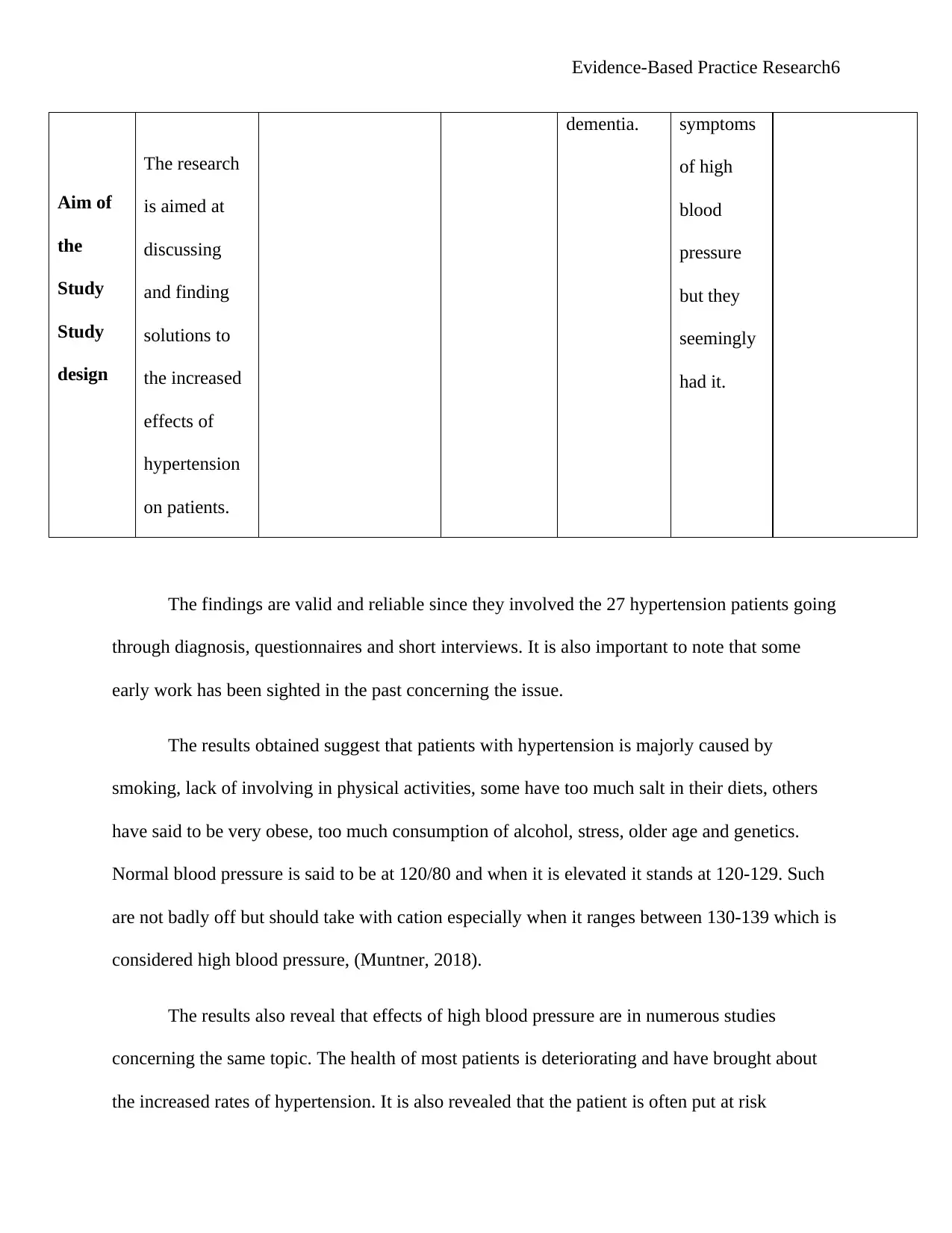
Evidence-Based Practice Research6
Aim of
the
Study
Study
design
The research
is aimed at
discussing
and finding
solutions to
the increased
effects of
hypertension
on patients.
dementia. symptoms
of high
blood
pressure
but they
seemingly
had it.
The findings are valid and reliable since they involved the 27 hypertension patients going
through diagnosis, questionnaires and short interviews. It is also important to note that some
early work has been sighted in the past concerning the issue.
The results obtained suggest that patients with hypertension is majorly caused by
smoking, lack of involving in physical activities, some have too much salt in their diets, others
have said to be very obese, too much consumption of alcohol, stress, older age and genetics.
Normal blood pressure is said to be at 120/80 and when it is elevated it stands at 120-129. Such
are not badly off but should take with cation especially when it ranges between 130-139 which is
considered high blood pressure, (Muntner, 2018).
The results also reveal that effects of high blood pressure are in numerous studies
concerning the same topic. The health of most patients is deteriorating and have brought about
the increased rates of hypertension. It is also revealed that the patient is often put at risk
Aim of
the
Study
Study
design
The research
is aimed at
discussing
and finding
solutions to
the increased
effects of
hypertension
on patients.
dementia. symptoms
of high
blood
pressure
but they
seemingly
had it.
The findings are valid and reliable since they involved the 27 hypertension patients going
through diagnosis, questionnaires and short interviews. It is also important to note that some
early work has been sighted in the past concerning the issue.
The results obtained suggest that patients with hypertension is majorly caused by
smoking, lack of involving in physical activities, some have too much salt in their diets, others
have said to be very obese, too much consumption of alcohol, stress, older age and genetics.
Normal blood pressure is said to be at 120/80 and when it is elevated it stands at 120-129. Such
are not badly off but should take with cation especially when it ranges between 130-139 which is
considered high blood pressure, (Muntner, 2018).
The results also reveal that effects of high blood pressure are in numerous studies
concerning the same topic. The health of most patients is deteriorating and have brought about
the increased rates of hypertension. It is also revealed that the patient is often put at risk
⊘ This is a preview!⊘
Do you want full access?
Subscribe today to unlock all pages.

Trusted by 1+ million students worldwide
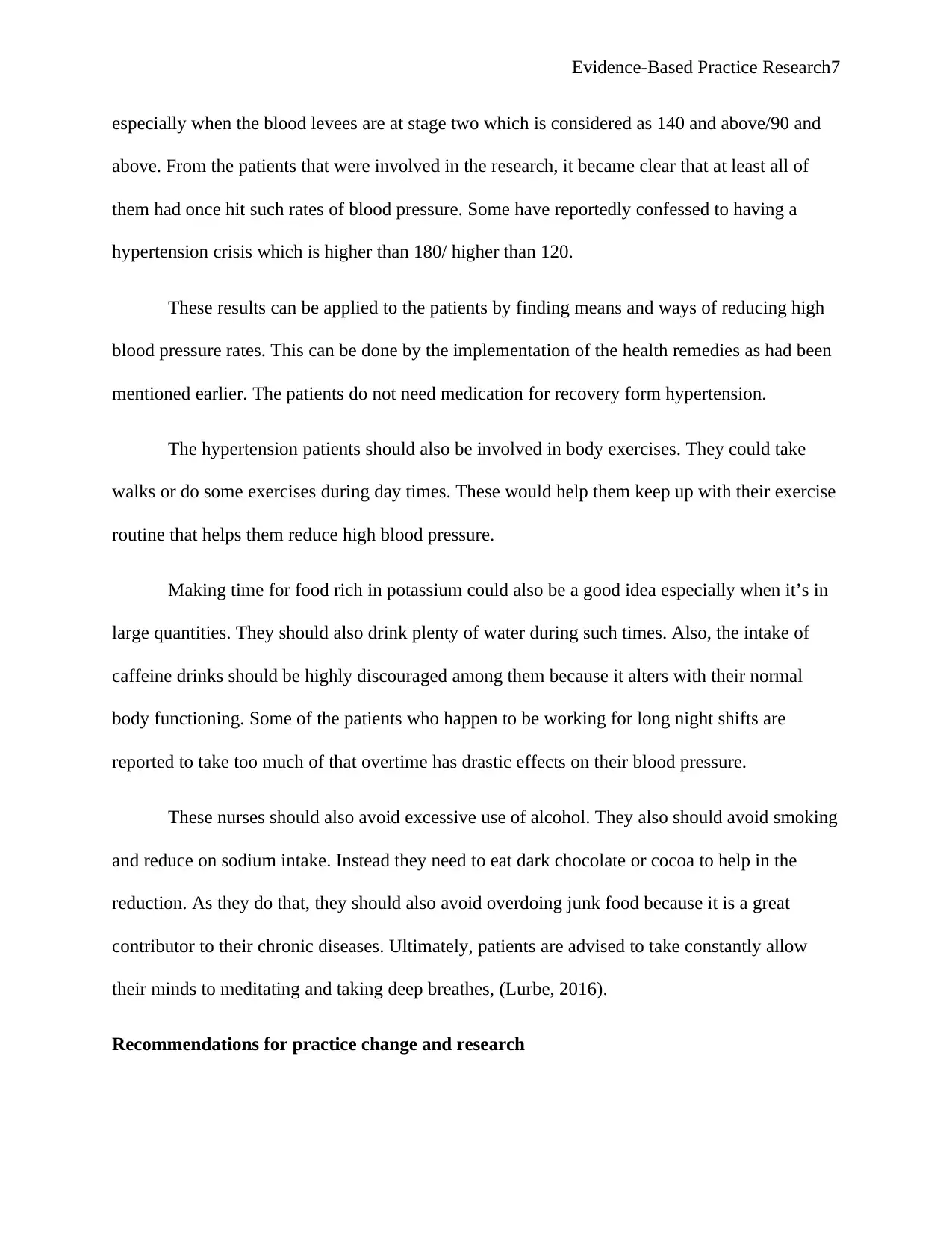
Evidence-Based Practice Research7
especially when the blood levees are at stage two which is considered as 140 and above/90 and
above. From the patients that were involved in the research, it became clear that at least all of
them had once hit such rates of blood pressure. Some have reportedly confessed to having a
hypertension crisis which is higher than 180/ higher than 120.
These results can be applied to the patients by finding means and ways of reducing high
blood pressure rates. This can be done by the implementation of the health remedies as had been
mentioned earlier. The patients do not need medication for recovery form hypertension.
The hypertension patients should also be involved in body exercises. They could take
walks or do some exercises during day times. These would help them keep up with their exercise
routine that helps them reduce high blood pressure.
Making time for food rich in potassium could also be a good idea especially when it’s in
large quantities. They should also drink plenty of water during such times. Also, the intake of
caffeine drinks should be highly discouraged among them because it alters with their normal
body functioning. Some of the patients who happen to be working for long night shifts are
reported to take too much of that overtime has drastic effects on their blood pressure.
These nurses should also avoid excessive use of alcohol. They also should avoid smoking
and reduce on sodium intake. Instead they need to eat dark chocolate or cocoa to help in the
reduction. As they do that, they should also avoid overdoing junk food because it is a great
contributor to their chronic diseases. Ultimately, patients are advised to take constantly allow
their minds to meditating and taking deep breathes, (Lurbe, 2016).
Recommendations for practice change and research
especially when the blood levees are at stage two which is considered as 140 and above/90 and
above. From the patients that were involved in the research, it became clear that at least all of
them had once hit such rates of blood pressure. Some have reportedly confessed to having a
hypertension crisis which is higher than 180/ higher than 120.
These results can be applied to the patients by finding means and ways of reducing high
blood pressure rates. This can be done by the implementation of the health remedies as had been
mentioned earlier. The patients do not need medication for recovery form hypertension.
The hypertension patients should also be involved in body exercises. They could take
walks or do some exercises during day times. These would help them keep up with their exercise
routine that helps them reduce high blood pressure.
Making time for food rich in potassium could also be a good idea especially when it’s in
large quantities. They should also drink plenty of water during such times. Also, the intake of
caffeine drinks should be highly discouraged among them because it alters with their normal
body functioning. Some of the patients who happen to be working for long night shifts are
reported to take too much of that overtime has drastic effects on their blood pressure.
These nurses should also avoid excessive use of alcohol. They also should avoid smoking
and reduce on sodium intake. Instead they need to eat dark chocolate or cocoa to help in the
reduction. As they do that, they should also avoid overdoing junk food because it is a great
contributor to their chronic diseases. Ultimately, patients are advised to take constantly allow
their minds to meditating and taking deep breathes, (Lurbe, 2016).
Recommendations for practice change and research
Paraphrase This Document
Need a fresh take? Get an instant paraphrase of this document with our AI Paraphraser

Evidence-Based Practice Research8
From the five evidence sources I have identified, the limitations of the evidence-based
practice are that most of the best available evidence is not there. This is especially as we deal
with this issue of high blood pressure. One great limitation has been the current management
environment that has experienced drastic changes over the years. This has brought about the
limitation on relying on the experiential and scientific evidence generated. It has also become
increasingly difficult to have new skills in appraising, seeking and evidence developed by
practitioners. Developing these skills takes a lot of time and effort. These skills make the
practitioners prone to confirmation bias which focuses on the individual's judgment and personal
experiences.
The other limitation has been despite the recent emphasis on the continues instability of
the single BP measurements. In most cases, a variety of valid measurements that help in
assessing the patient’s high quality diagnostic accuracies are not very popular. This clearly
explains why most of the recommendations for the patients with high blood pressure have not
been implemented. This ultimately is the misuse of this practice. The evidence-based practice is
aimed at using evidence to determine the best models available through competent people. Most
of the practitioners have their decision making processes based on their up to date information.
They do not make decisions based on conclusive means or the best available evidence. These
become a great challenge.
Recommendations to these prevailing issues would be to have an increased education
concerning the evidence-based practice. It should be clear that evidence-based practice is not
aimed at reducing the costs incurred rather provide better healthcare. It matters high blood
pressure, the government needs to strict on the providing the necessary education needed for
people to improve their lifestyles.
From the five evidence sources I have identified, the limitations of the evidence-based
practice are that most of the best available evidence is not there. This is especially as we deal
with this issue of high blood pressure. One great limitation has been the current management
environment that has experienced drastic changes over the years. This has brought about the
limitation on relying on the experiential and scientific evidence generated. It has also become
increasingly difficult to have new skills in appraising, seeking and evidence developed by
practitioners. Developing these skills takes a lot of time and effort. These skills make the
practitioners prone to confirmation bias which focuses on the individual's judgment and personal
experiences.
The other limitation has been despite the recent emphasis on the continues instability of
the single BP measurements. In most cases, a variety of valid measurements that help in
assessing the patient’s high quality diagnostic accuracies are not very popular. This clearly
explains why most of the recommendations for the patients with high blood pressure have not
been implemented. This ultimately is the misuse of this practice. The evidence-based practice is
aimed at using evidence to determine the best models available through competent people. Most
of the practitioners have their decision making processes based on their up to date information.
They do not make decisions based on conclusive means or the best available evidence. These
become a great challenge.
Recommendations to these prevailing issues would be to have an increased education
concerning the evidence-based practice. It should be clear that evidence-based practice is not
aimed at reducing the costs incurred rather provide better healthcare. It matters high blood
pressure, the government needs to strict on the providing the necessary education needed for
people to improve their lifestyles.

Evidence-Based Practice Research9
Another recommendation would be an improved implementation of the research findings.
The processing of collecting findings on topics such as hypertension. Cost-efficient patient care
practices can be attained if the evidence-based practice is wholly adopted.
The uprising effects of high blood pressure could be dealt with having an improved
lifestyle. Doing this would reduce the high number of losses incurred during treatment of such
patients. Also, illnesses associated with hypertension will be greatly reduced. The Evidence-
based practice holds the necessary recommendations to be adopted in dealing with the effects of
high blood pressure, (Grove, 2019).
References
Association., A. H. (2017). What is high blood pressure?. South Carolina State Documents
Depository.
Flynn, J. T.-S. (2017). Clinical practice guideline for screening and management of high blood
pressure in children and adolescents. Pediatrics, 140(3), e20.
Another recommendation would be an improved implementation of the research findings.
The processing of collecting findings on topics such as hypertension. Cost-efficient patient care
practices can be attained if the evidence-based practice is wholly adopted.
The uprising effects of high blood pressure could be dealt with having an improved
lifestyle. Doing this would reduce the high number of losses incurred during treatment of such
patients. Also, illnesses associated with hypertension will be greatly reduced. The Evidence-
based practice holds the necessary recommendations to be adopted in dealing with the effects of
high blood pressure, (Grove, 2019).
References
Association., A. H. (2017). What is high blood pressure?. South Carolina State Documents
Depository.
Flynn, J. T.-S. (2017). Clinical practice guideline for screening and management of high blood
pressure in children and adolescents. Pediatrics, 140(3), e20.
⊘ This is a preview!⊘
Do you want full access?
Subscribe today to unlock all pages.

Trusted by 1+ million students worldwide
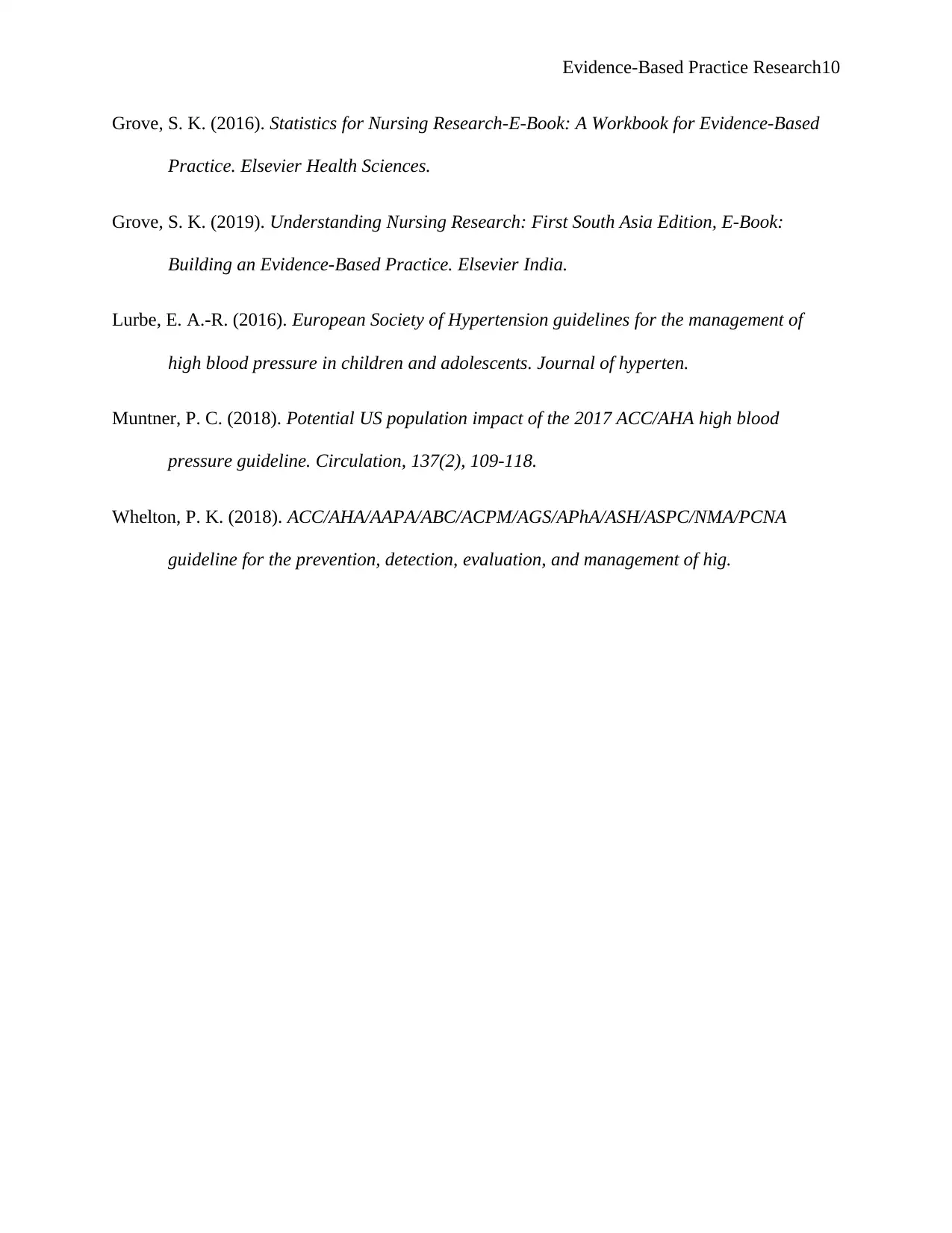
Evidence-Based Practice Research10
Grove, S. K. (2016). Statistics for Nursing Research-E-Book: A Workbook for Evidence-Based
Practice. Elsevier Health Sciences.
Grove, S. K. (2019). Understanding Nursing Research: First South Asia Edition, E-Book:
Building an Evidence-Based Practice. Elsevier India.
Lurbe, E. A.-R. (2016). European Society of Hypertension guidelines for the management of
high blood pressure in children and adolescents. Journal of hyperten.
Muntner, P. C. (2018). Potential US population impact of the 2017 ACC/AHA high blood
pressure guideline. Circulation, 137(2), 109-118.
Whelton, P. K. (2018). ACC/AHA/AAPA/ABC/ACPM/AGS/APhA/ASH/ASPC/NMA/PCNA
guideline for the prevention, detection, evaluation, and management of hig.
Grove, S. K. (2016). Statistics for Nursing Research-E-Book: A Workbook for Evidence-Based
Practice. Elsevier Health Sciences.
Grove, S. K. (2019). Understanding Nursing Research: First South Asia Edition, E-Book:
Building an Evidence-Based Practice. Elsevier India.
Lurbe, E. A.-R. (2016). European Society of Hypertension guidelines for the management of
high blood pressure in children and adolescents. Journal of hyperten.
Muntner, P. C. (2018). Potential US population impact of the 2017 ACC/AHA high blood
pressure guideline. Circulation, 137(2), 109-118.
Whelton, P. K. (2018). ACC/AHA/AAPA/ABC/ACPM/AGS/APhA/ASH/ASPC/NMA/PCNA
guideline for the prevention, detection, evaluation, and management of hig.
1 out of 10
Related Documents
Your All-in-One AI-Powered Toolkit for Academic Success.
+13062052269
info@desklib.com
Available 24*7 on WhatsApp / Email
![[object Object]](/_next/static/media/star-bottom.7253800d.svg)
Unlock your academic potential
Copyright © 2020–2025 A2Z Services. All Rights Reserved. Developed and managed by ZUCOL.




